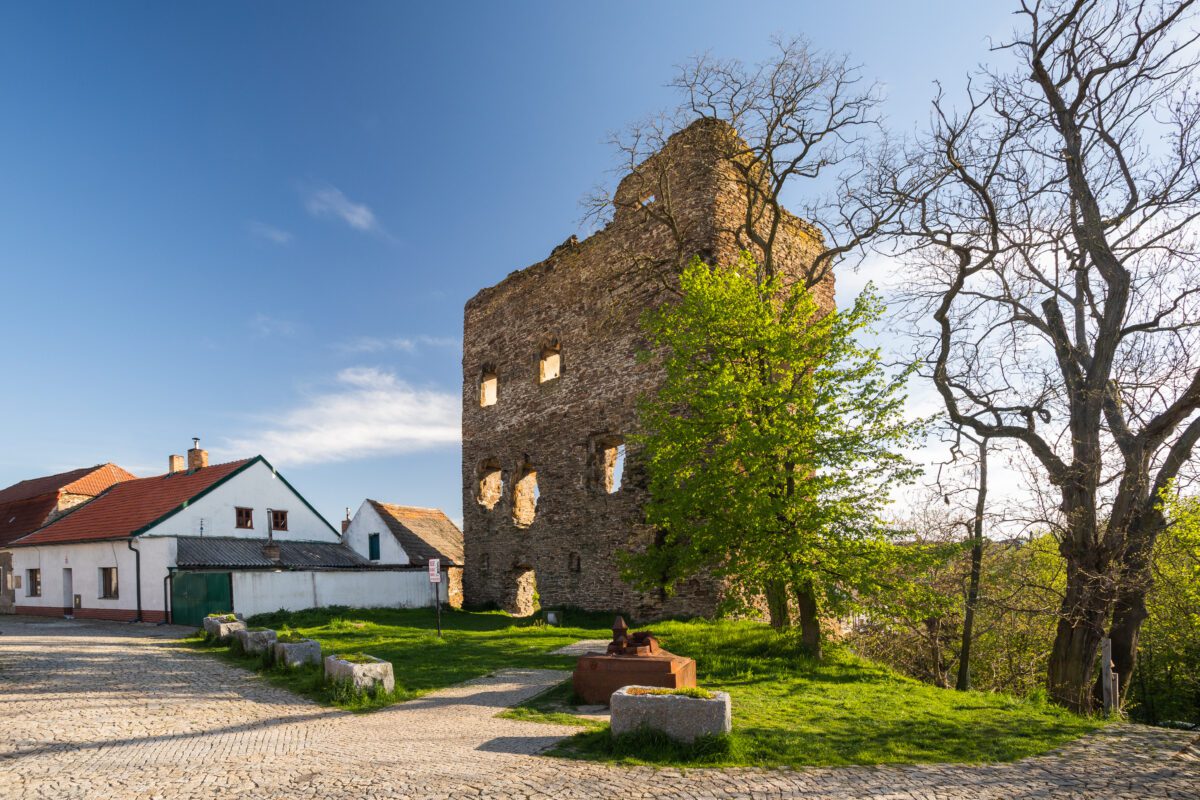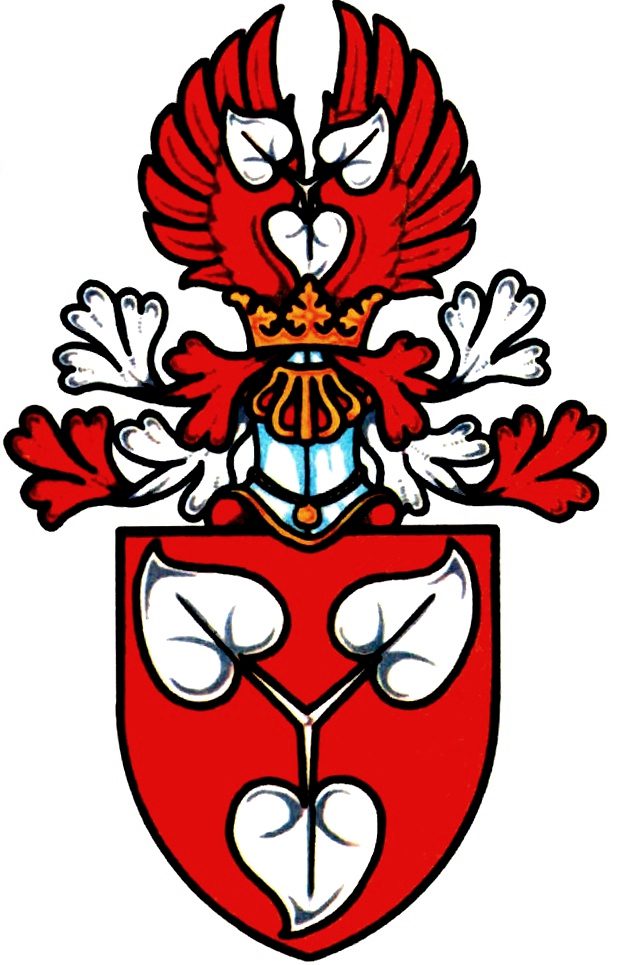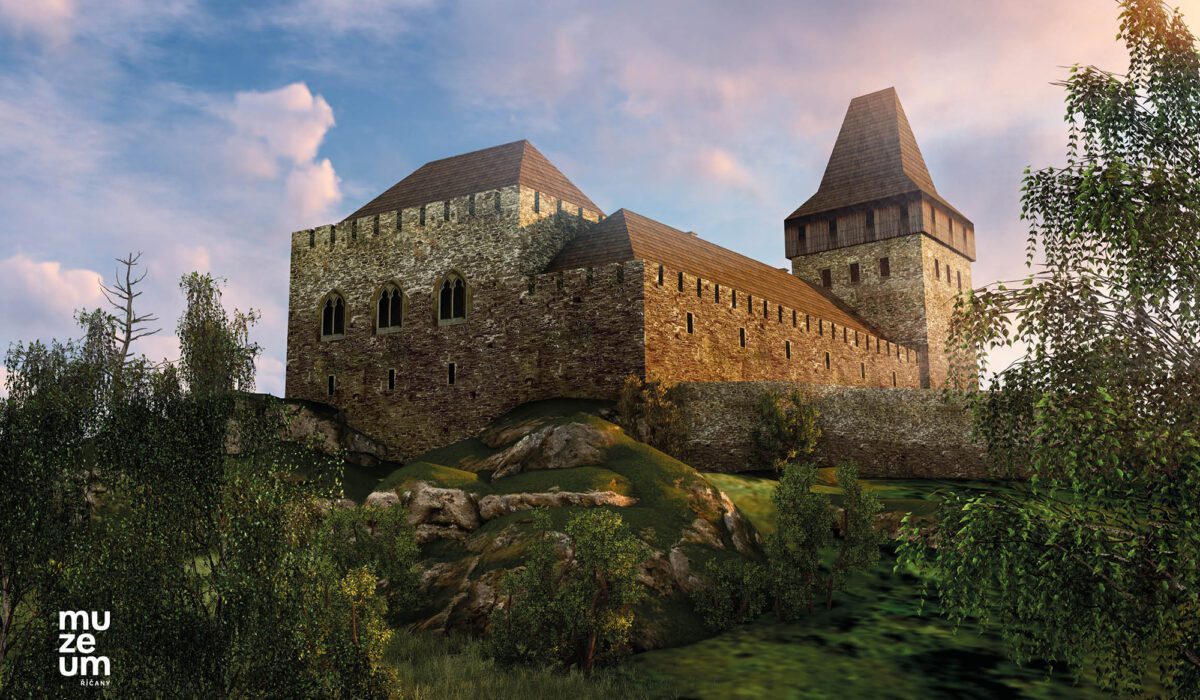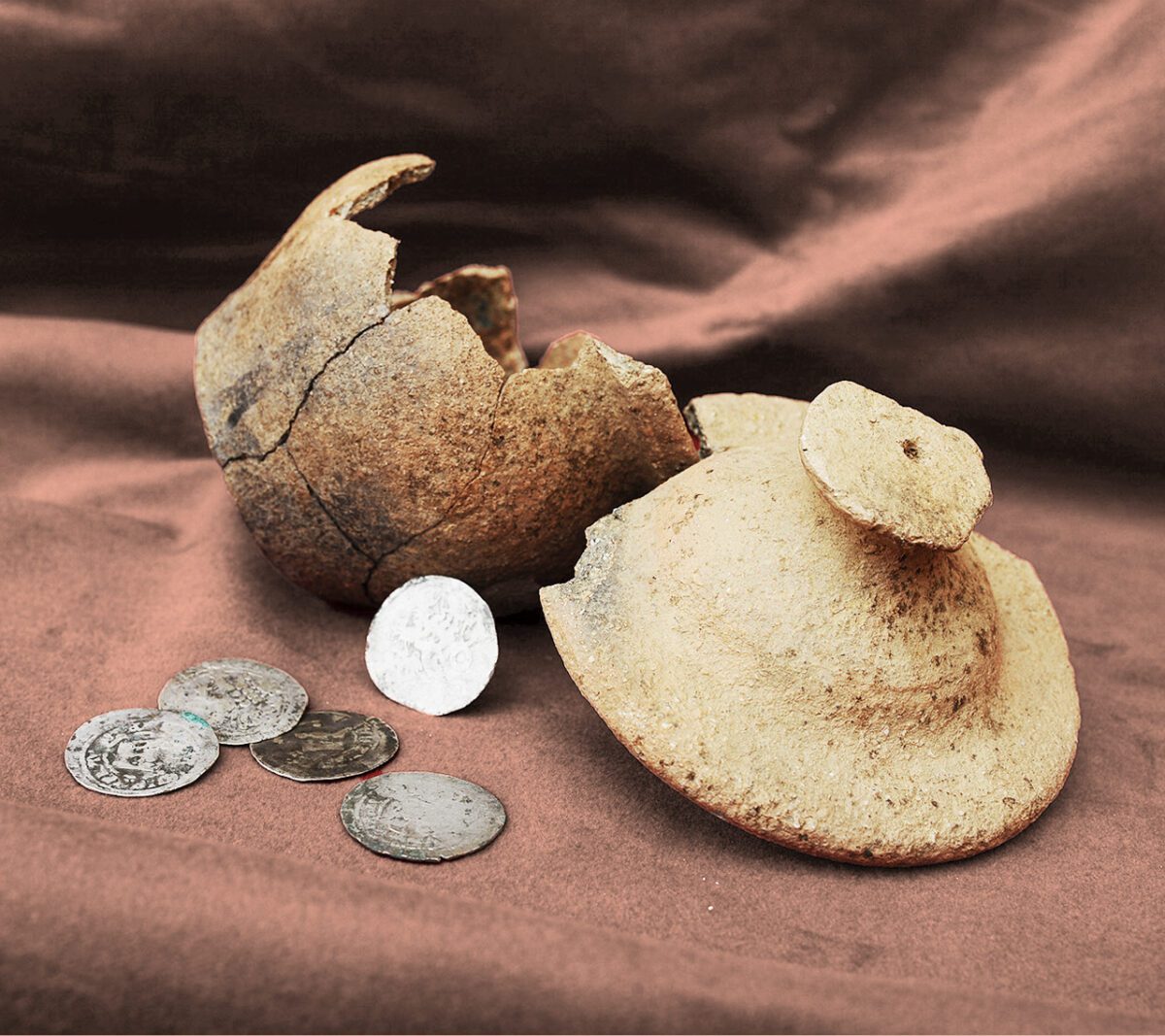Říčany Castle

On the promontory above the Mlýnský and the now defunct Lázeňský Pond, built along the course of the Říčanský Brook, stand the remains of a once majestic and unusually grand for its time early Gothic castle.
The builder of Říčany castle was probably Ondřej, the original surname from nearby Všechry, where his family originally came from. This nobleman was a loyal servant of King Přemysl Otakar II, whom he served faithfully first as a personal chamberlain with the function of a butler, and later, from 1260, he held the office of supreme chamberlain.
Such a political position, however, required an adequate, sufficiently representative residence and gave rise to the construction of the castle (probably in 1260-1270). In written sources, Říčany is first unquestionably mentioned in 1289. The settlement area of Říčany at that time consisted of a castle complex, a church (today’s Church of St. Peter and Paul) and a settlement on the square or along the trade route in today’s Široká Street. The town centre has retained essentially the same shape since the Middle Ages, even the land division on Masaryk Square still largely honours the original medieval layout.
The Lords of Říčany and the exceptional appearance of the castle

It was only Ondřej’s grandson Oldřich, who was the highest provincial judge in 1309-25, i.e. one of the leading representatives of the kingdom, who began to use the surname of Říčany with certainty. For nearly 100 years the family of the Lords of Říčany remained at the forefront of the political elite of the Bohemian Kingdom. Other successors of Ondřej and Oldřich also held high state offices and were among the most loyal supporters of the Czech kings. In addition to military and judicial functions, the lords of Říčany also held, for example, the functions of chamberlains, i.e. administrators of the royal treasury. They maintained their place in the limelight even after the accession of the Luxembourgers to the throne.
The coat of arms of the lords of Říčany was represented by three white water lily leaves connected by a stem in the middle of a red shield, the so-called triple leaf. The same three leaves, placed between two red wings, also served as the jewel of several family lines. The shield with three water lily leaves is still the emblem of the town of Ledeč nad Sázavou as a memorial to the former Ledečská lords of Říčany. Older versions of the coat of arms can be found in the castle in Písek and in the church in Dolní Jirčany. In contrast to most other Czech families, the so-called “Lords of Říčany” have not been preserved. coat of arms legend. So we have no idea what the significance of the water lily trifolium is. We can assume that it refers to the ponds below the castle (only the Mill Pond has survived to this day, the Spa Pond was drained in the 19th century), which played a crucial strategic role in the defence of the castle and at the same time provided space for profitable farming.
The family castle
Říčany Castle is one of the most important buildings of the Czech castle architecture of the time of the last Přemyslids. It was built at a time when half-timbered noble castles were being replaced by more robust Gothic castles and is therefore an example of the oldest stone castles in the Czech Republic. The castle is built according to the most advanced variant of the Saxon-Hessian castle type, in which the formerly free-standing defensive and residential tower (donjon) is attached to the castle wall and the castle palace appears together with other buildings.


The appearance of Říčany, however, does not appear in the context of the noble castle architecture of the 2nd half of the 19th century. 13th century, both in the use of the square tower and in the overall layout with the perimeter buildings. Also striking is the very high quality of the architectural elements showing the work of the Royal Ironworks. Only a wealthy nobleman from the ruler’s immediate surroundings could afford to build such a miniature of a royal castle. Only two cases are known – the castles of Říčany and Vízmburk. Říčany thus represents one of the absolute peaks of aristocratic castle construction 13. century.
The form of a noble residence
The roughly oval-shaped castle stood on a wide promontory. It was protected by a low cliff, a massive wall two storeys high, an ingenious system of ponds on three sides (of which only one exists today) and a deep moat with ramparts against the town. The core of the castle was dominated by two partially preserved buildings – the donjon and the palace. The Donjon of Říčany castle was a square and probably two-storey tower with flat ceilings and a wall thickness of 2.7 metres. It stood at the entrance from the forecourt to the inner castle. Other buildings adjoined it on both sides.

The main early Gothic palace of the castle was a two-storey building made of rubble stone with walls 1.8 metres thick. It was a building without differentiation of residential functions. The ground floor, covered with a flat beamed ceiling, had an entrance directly from the courtyard and consisted of a single spacious room measuring about 5×13 m, lit by two narrow windows from the courtyard. It served as a supply depot, a storehouse for food, weapons and ammunition. The same hall with two barred windows was also on the first floor. It was entered from a wooden courtyard pavilion connecting the palace with the adjacent lower one-storey palace building. There was no internal connection between the floors.
Above it, the palace had a main hall heated by a fireplace, vaulted with three bays of cross vaulting and accessible from the attic of the neighbouring residential wing. The second floor was illuminated by two Gothic compound windows with triple circles in the tops. There were stone seats in the deep niches underneath. All the life of the castle lord and his family was concentrated here. The hall was furnished with the most necessary furniture, which included chests along the walls, which served as wardrobes and dressers and initially as beds, as well as several chairs and a large table. Part of the equipment used to be a prevet – a toilet in a bay window on cracks with a direct drain along the outer wall. This room was used for sleeping, eating and working. Guests were received here, but also children were born and died here. Family members lived here without any privacy. The palace was covered by a roof floor – a wooden structure with a gable roof wrapped by a gallery with a stone battlement.
The Hussite Wars and the departure of the Lords of Říčany
At the beginning of 15. century, the Catholic nobleman Diviš of Říčany, a supporter of the Czech kings and Emperor Sigismund and an active opponent of the Hussites, resided at Říčany Castle. In 1415 he signed, together with many other noblemen, an appeal to Sigismund of Luxembourg, in which the Czech lords called on the Hungarian monarch to intercede for the release of Jan Hus from the prison in Constance, but the political loyalty of the lords of Říčany eventually prevailed over religious sympathies. After the Prague defenestration, Diviš of Říčany even allowed Sigismund’s troops to spend the night in the castle’s castle grounds when the crusaders marched through the castle towards the battles at Vitkov and Vyšehrad. But the Catholics suffered crushing defeats in these clashes. In November 1420, a few months later, the armies of the Praja and the campers led by Jan Žižka marched to Říčany. Hussite troops besieged Divis at his castle. The Ricans were forced to surrender after less than 14 days of siege. The Hussites did not conquer the castle by a military attack, but de facto they managed to starve the castle’s garrison by cutting them off from the supply routes and occupying the unprotected area of the town. Diviš was captured and imprisoned when he left the castle together with his family and the camp crew. Eleven Catholic priests, whom he granted asylum, were immediately burned in a nearby peasant’s den (or tavern, records differ) on Jan Žižka’s orders. The Hussites did not destroy the castle, but occupied it with their own garrison. It remained in the possession of the Prague citizens until 1485. The lords of Říčany never returned to their original family seat…
Říčany Castle was conquered by the Hussites in 1420. Without a fight, simply starving the crew was enough. The Hussite wars then shuffled the cards of history so that the lords never returned to their ancestral seat.
The castle and the property associated with it passed into foreign hands, changed hands several times and the castle was probably neither inhabited nor maintained. During the reign of the Trčků of Lípa (1485-1544) it was completely left to its fate. In 1544 it is already explicitly mentioned as deserted. In the 1785 Josef Land Register it is listed as “an old manor castle, in which only stone quarries are found, also of no use”.
Říčany Treasure
Probably in 1419, an unknown landlord hid his fortune in the only surviving medieval cellar in Říčany Square. He put 348 silver Prague groschen (one of which later turned out to be fake) into a ceramic pot and hid the pot in the stone wall of the Gothic cellar. But he never retrieved his treasure. We assume that the fate of this man was directly connected with the conquest of Říčany Castle by the Hussites, during which he may have been killed or captured. In any case, he didn’t reveal his hiding place to anyone. The house, to which the cellar belonged, later disappeared and only in the 18th century. century, a new building was erected on its site, which has been preserved to this day. The original Gothic cellar was only discovered in the early 1990s. 20 years. century as a result of a water leak and while exploring it, the Škáb family discovered this silver treasure. In 2018, Martin Škába, a participant in the discovery, donated the treasure, which is probably the most valuable relic of Říčany’s Middle Ages, to the state. Besides the finds of weapons and cannonballs, the treasure found is one of the few tangible proofs of the conquest of Říčany Castle. The treasure is on display in the museum in Brandýs nad Labem. The Říčany Museum exhibited it in November 2023.


The currentappearance of the monument
Most castles of this type and age are preserved today only in plan, with at most the torso of a tower. Říčany is a complete exception, because almost the entire courtyard facade and one cross wall of the main palace have been preserved, practically in full height. Apart from it, the corner of the donjon, a small part of the court wall of the lower palace building and a well in the centre of the courtyard have been preserved. Most of the rest of the castle has been swallowed up by the surrounding town, so its former perimeter is now barely recognizable in the new development. Říčany castle was gradually dismantled by local inhabitants into building stone. The slate promontory on which the castle palace stood was also removed. Demolition of the castle stone was stopped only in the middle of the 19th century. century, when the local inhabitants began to realize its historical value and the castle began to be the subject of frequent trips by Prague tourists.
In 2000, extensive research was carried out in the castle area by the Institute of Archaeology of the CAS. This significantly brought the possibility of learning the real appearance of the castle closer. In addition, over 6,000 pieces of materials (pottery, bones, tiles, iron, glass, porcelain, etc.) were found in eight research probes.